The Petite Ceinture: A 2025 Update
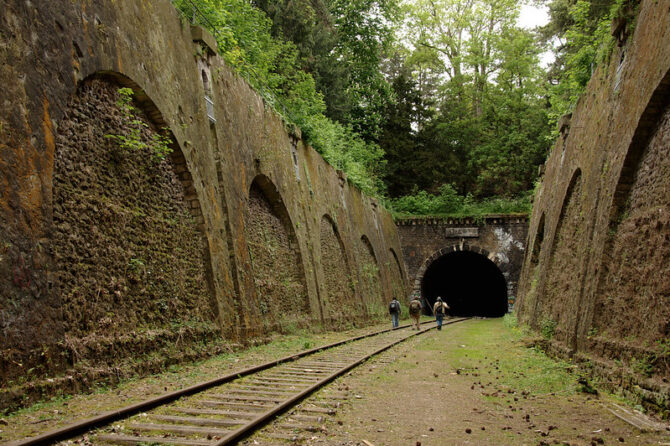

- SUBSCRIBE
- ALREADY SUBSCRIBED?
BECOME A BONJOUR PARIS MEMBER
Gain full access to our collection of over 5,000 articles and bring the City of Light into your life. Just 60 USD per year.
Find out why you should become a member here.
Sign in
Fill in your credentials below.
In a previous article, I wrote about the history of the Petite Ceinture and the ongoing efforts to reopen sections of this disused railway line to the public. 2024 saw several new sections become accessible and this continues into 2025, including the establishment of an ambitious “urban forest” in the 20th arrondissement.
The Petite Ceinture was a railway that encircled the outer arrondissements, first opening to traffic in 1852. As the Métro gained in popularity in the early 20th century, so the Petite Ceinture fell out of use. It finally closed to passengers in 1934, although it carried freight traffic right through to the 1980s.
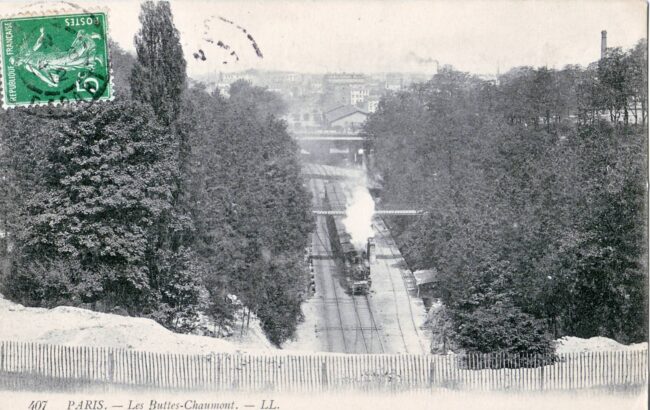
The Petite Ceinture traversing a section of the Parc des Buttes-Chaumont (1912). Public domain
Within a few years the project to reopen the railway line as a public amenity was launched, and since 2013 it has enjoyed the support of the Ville de Paris. Around 10 km of the total length (32 km) has been transformed into linear parks. This has not been achieved easily: around a third of the line is composed of tunnels, which are expensive not only to restore, but also to bring up to modern safety standards (eg. an escape exit has to be excavated every 200m). This means that reopened sections are still isolated from each other.
Moreover, the trackbed and surviving infrastructure such as rails, bridges, etc are still owned by the SNCF who reserve the right to reopen the line for rail use in the future. This is also part of the reason why it has taken so long to achieve the limited accessibility we have today. Each time a stretch is proposed for restoration, the proposal has to be approved by the SNCF. In fact, the agreement with the Ville de Paris stipulates that any restoration work such as new planting and installing street furniture must be reversible, or at least, not interfere with the potential restoration of a working railway.
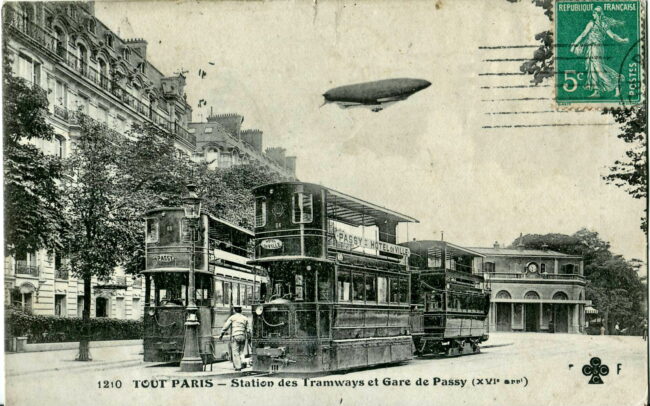
Gare de Passy, early 20th century. Public domain
But as more and more sections are reopened, tension between the two visions for the Petite Ceinture is rising and this agreement runs the risk, to coin a phrase, of hitting the buffers. The Association for Safeguarding the Petite Ceinture (ASPCRF) is particularly active in supporting a future return to rail use, even more than the SNCF itself, and closely monitors restoration work. The main railway workers’ union also sees the return of a working railway as important for carrying goods around Paris without adding to road congestion and pollution. They have a point, especially since the Petite Ceinture was deliberately built to link with the mainline railway stations, so in theory at least, it should be relatively easy to bring back a joined-up transport network for carrying goods around Paris.
Opposing this view are the Greens and their supporters who argue that the conversion of the line into parkland provides a much-needed “green lung” for the city, which regularly tops polls for its lack of green spaces relative to its size. Local arrondissement mairies are closely involved in plans for the Petite Ceinture and, not surprisingly, tend to favor a return to nature.
Two of the most recent projects highlight both of these dilemmas and visions. In the 13th arrondissement, the rails were lifted in 2017 around Maison Blanche Métro to allow for a massive cement silo to be built while the extension works on Line 14 took place. The ASPCRF has noted that they’ve only just been put back since the extension opened last year. Further along the railway, the mairie of the 13th has given the go-ahead for the nature conversion of a stretch alongside the Rue de Regnault, which also has a branch line converging from the former Gare des Gobelins. This used to be the largest goods warehouse in Paris – and, potentially, in the future. Although these works won’t be finished until 2027, the ASPCRF has complained that the plans show the branch line heavily planted with trees and argues that this will prevent any future return to railway use. On the other hand, the plans also show grassed and seating areas which will be very pleasant for walkers. Both uses would be good for the environment – but which should take priority? A headache – or, as the French call it, une casse-tête – for the decision-makers.
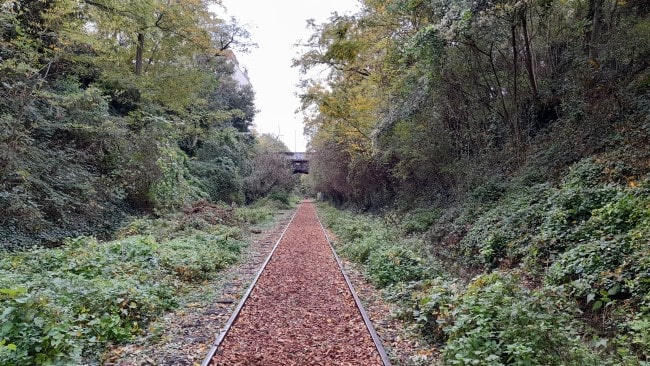
A section of the Petite Ceinture in the 14th arrondissement. Photo: Pat Hallam
A much bigger project in the 20th arrondissement began last year and seems to be rather less controversial. The stretch between the Rue Volga and the Cours de Vincennes opened last July and eventually an “urban forest” of some 2000 trees will cover the entire section. The tramway 3b runs alongside the old railway which is almost literally a stone’s throw from the Periphérique in one of the most densely-populated areas of Paris so this will be a very welcome addition to the city’s green spaces. The old goods station still overlooks the current Jardin de la Gare de Charonne and the new plantation and remodeling of the trackbed will provide a continuous promenade of 3.5 hectares. It forms part of the Ville de Paris’ vision of urban forests across the city, including the plaza in front of the Hôtel de Ville, in its attempt to accommodate climate change. The “forests” will create “cool islands” that should bring down local temperatures during extreme heatwaves.
Other plans to join up sections of the Petite Ceinture are under discussion in the 18th arrondissement. Two short sections of 200m and 400m have recently opened, or are just about to open. One connects the cultural centre Le Hasard Ludique with the Rue Vauvenargues; the other will link La Recyclerie with the Rue du Poteau. A third section will link the Boulevard Ornano with the Rue des Poissoniers hard up against the main railway line coming out of Gare du Nord. Even more ambitiously, ideas are forming about creating a long promenade going all the way up to the Rosa Parks interchange on the far side of the 19th arrondissement.
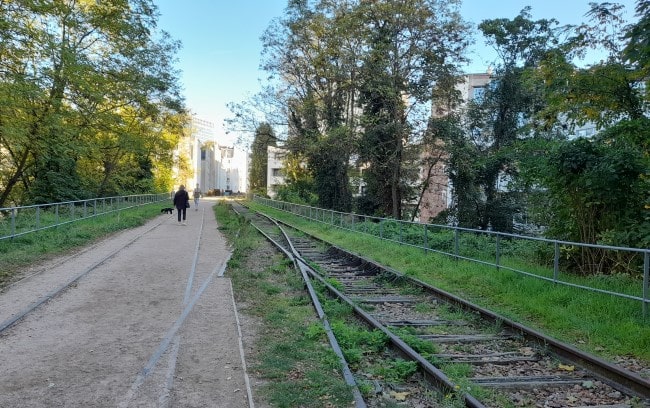
Original tracks in the 15th arrondissement. Photo: Pat Hallam
The 15th arrondissement boasts the longest sections of the Petite Ceinture to have opened so far, and another will add a further 400m in 2025, linking the Parc George Brassens to the Rue Briançon. Meanwhile in the 12th, work is underway to reopen a stretch between Charenton and Bercy, possibly to end on the banks of the Seine. Thus the Petite Ceinture is being transformed slowly, meter by meter, and brought back in use. The focus may shift in the coming years towards joining up all these isolated sections into a continuous promenade. One vision is to reopen 20km, or two-thirds, of the railway line connected by green sidewalks alongside the roads, which will bypass the tunnels making up the remaining 10km. The long term vision is to have a single linear park covering some 60 hectares, but who knows how long it will take to come to fruition.
If you want to find where the Petite Ceinture is open to the public, this link will take you to the Ville de Paris website.
Lead photo credit : La Petite Ceinture. Photo: Céline Harrand / Flickr
More in architecture, Art, Building, history, Petite Ceinture, Railway, travel, Trending


